As South Dakota State grows, the university’s dedication to sustainability has become more apparent through features within new buildings.
Just because campus is growing at an exponential rate doesn’t automatically mean more energy consumption, said Barry Mielke, director of energy systems at South Dakota State.
“As we build new buildings here on campus, they are typically more energy efficient and use less energy per square foot,” Mielke said.
The university measures consumption using units of heat called British thermal units (Btu). Mielke said Btu consumption per square foot has decreased over the past decade, resulting in a cost drop from $1.41 per square foot in 2008 to $1.30 per square foot in 2018.
SDSU uses many tactics to effectively lower energy consumption.
One strategy includes designing buildings within Leadership in Energy and Environmental Design (LEED) standards. These standards include proper insulation and sustainable materials. SDSU is home to several LEED silver and gold certified buildings.
According to the SDState website, silver rankings include Jackrabbit Village and the Sanford Jackrabbit Athletic Complex.
The Dykhouse Athletic Center was ranked gold in 2010.
This year, Harding Hall received a LEED silver ranking, adding to the university’s accolades.
Mielke said SDSU also uses LED lights and heating and cooling systems connected to sensors.
Not only do these improve efficiency, but they also prevent rooms from being unnecessarily lit or heated when unoccupied.
Sustainable energy is a major goal of the university.
Mielke said SDSU plans to install multiple 50 kilowatt solar panels on top of the Stanley J. Marshall building.
All of this energy consumption can be lowered, Mielke said. Energy usage can be further decreased by turning off lights and electronics when not in use and by turning down the thermostat in the winter and up in the summer.
Following through on these steps will help SDSU improve the overall sustainability of campus.


















